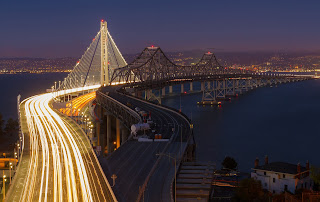It’s a familiar sort of news item these days: A huge and vastly expensive bridge being proposed in California will forever alter one of the Golden State’s most spectacular marine panoramas. It will be the largest of its type ever built, stretching over a mile and a half between landfalls, towering nearly 700 feet above the water, and carrying six lanes of traffic into a once-isolated area containing some of the state’s most unspoiled stretches of coastline.
 |
| The Golden Gate Bridge under construction, circa 1936. |
Here come years of political acrimony, debate over cost and viability, interference by special interests, uproar over environmental impact, and all the rest, right?
Wrong. You won’t hear any of this, because the bridge in question was completed across San Francisco’s incomparable Golden Gate seventy-five years ago—in an era when ambitious engineering projects were met with unity of purpose rather than fractious bickering. This may explain why the Golden Gate Bridge could be built in the incredibly short span of 51 months, and at a final cost that was $1.3 million below budget.
Granted, the bridge’s road to completion wasn’t a smooth one. The idea of bridging the Golden Gate had long been pondered, but only in 1916 was any real action taken toward this goal. In the interim came the Great Depression and a series of financial setbacks to the project. Still, construction on one of the most inhospitable sites in history began on January 5, 1933. Four years and four months later, on May 28, 1937, the bridge was opened to traffic. Total cost: $35 million (about $1.2 billion in current dollars).
 |
| The Bay Bridge Replacement Span, under construction from 2002 until 2013. |
Contrast these statistics with those of another project that’s finally been completed just a few miles inland from the Golden Gate, on a shallow and far less challenging site. It’s a new, purportedly earthquake-safe bridge intended to replace the eastern span of the San Francisco-Oakland Bay Bridge, a portion of which collapsed in the Loma Prieta earthquake of 1989. Since the old bridge carried some 270,000 vehicles per day, the prospect of another collapse forced a decision to replace it with a safer span before an even bigger quake came along.
A fairly urgent undertaking, no? Yet instead of unity of purpose, there ensued more than a decade of political wrangling over economic, aesthetic, engineering and environmental issues. Construction finally began a dozen years later, in 2002, attended by the first of many subsequent sticker shocks: The lone construction bidder came in at $1.4 billion--almost twice the State’s projected cost of $780 million.
 |
| The completed span is still mired in controversy. The old bridge, on the right, is currently being dismantled. |
Today, more than twenty-six years after the Loma Prieta earthquake, the intended replacement bridge is finally open, at an estimated total construction cost of $6.3 billion—over eight times the original estimate. Yet the bridge is still embroiled in controversy, this time having to do with some critical construction members that are failing. The arguments about whether the new bridge is truly safe or not continue.
On the one hand, then, we have a truly daunting engineering challenge, undertaken in difficult economic times on a site that many declared unbuildable, that was nevertheless completed in record time and under budget. On the other, we have an urgent and relatively straightforward project that’s been mired in red tape and controversy for over a quarter of a century.
As the Golden Gate Bridge approaches its eightieth year, one has to lament the disparate outcomes in this tale of two bridges, and what they say about America today. Here’s to you, Golden Gate Bridge—it’s a shame we can’t seem to build ‘em like you anymore.
 |
| Makes you really appreciate how they pulled off this miracle all those years ago. |










